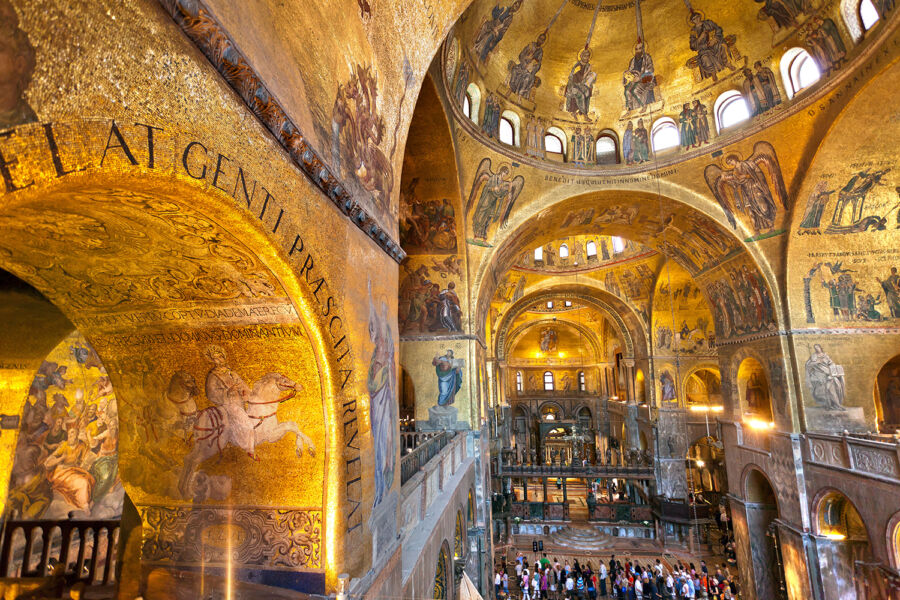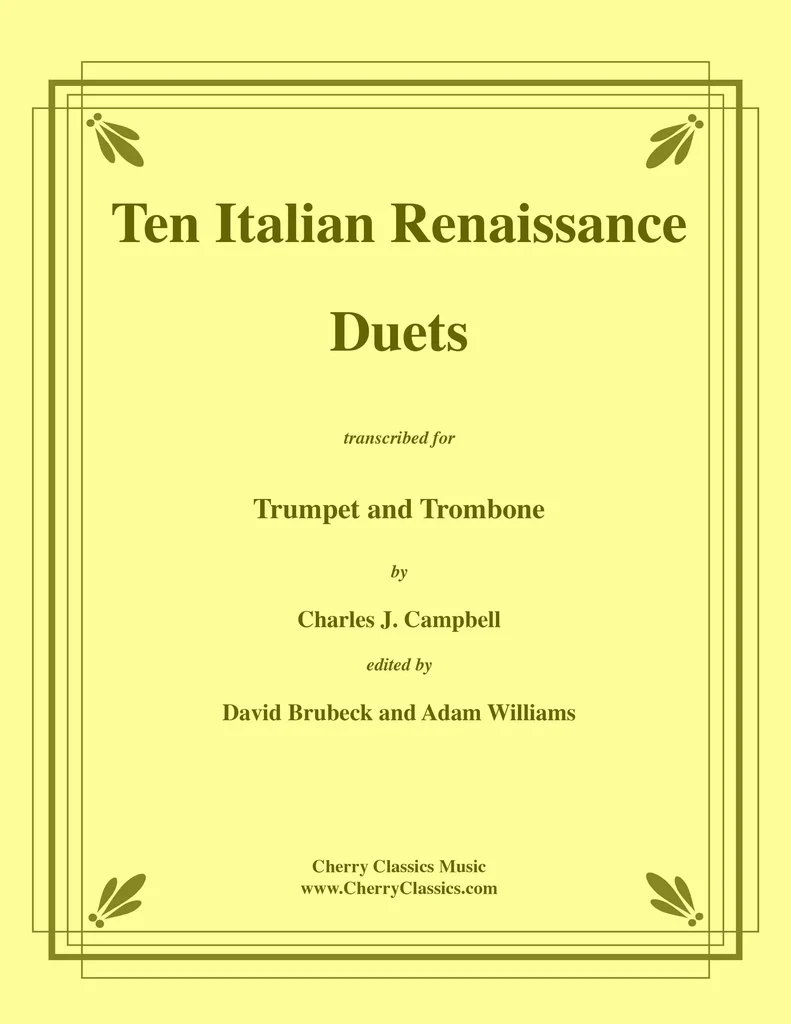Imagine being handed a folder with fifty pages of duo music for trumpet and trombone; like an incomplete map to a treasure! The only date? 1595. The only instrumentation? Trumpet in treble clef ‘C’ and trombone in bass clef.
The probable location is Venice, and possibly Basilica San Marco in La Serenissima -(St. Mark’s, Venice), but truly yet to be fully determined.

What could have been the purpose of this music? Were they training duets to prepare the players for the more typical music of the Gabrielis and Schutz? Could St. Mark’s, or another Basilica possibly have used just two brass to accompany religious services? This seems likely in the Orthodox Christian Basilica of St. Mark’s in Venice, but less likely in most of the rest of Italy which was dominated by Rome instead of Venice’s patron-Constantinople.
The keys seem to focus around ‘C’ Major or ‘F’ Major, but the presence of accidentals and available notes in the upper part would certainly seem to indicate the use of cornetto-which is more typical for St. Mark’s and Venice.
The presence of rests throughout at first seemed to suggest a missing part. Could it have been a vocal part or perhaps organ? One can almost hear the missing parts reverberate n the typical Venetian-Brass style.
The range of the trombone would certainly have to be restricted, due to elemental technique and trombone workmanship, at least one would think. No jumping around like, well, the arrangements by Brubeck-Neal or Stereograms. Right?
FEATURED DUO BRASS RECORDING: Canzona Francesca a’ 4 del Segundo Tuono
With a bit of an air of the musical equivalent of an expedition by Howard Carter or at least Indiana Jones, we set out to sight-read and record (in one or two takes each), these magnificent duos! Duo Brass, featuring Morgen Low and David Brubeck, met for a two-hour stint. Recordings were made direct to iPhone. (Recommended listening on over-the ear headphones!)
We probably made it through about 85% of the impressive stack of mixed brass duo music from the Renaissance. One composition was complicated, another missing a page, yet another a bit unwieldy with multiple pages-an entire MASS for brass duo for goodness sake!
This would be possible at St. Mark’s, where Catholic Monteverdi and Protestant Heinrich Schutz served side-by-side as Co-Music Directors for a time. Although the Catholic Church had a seat placed right in front of the pulpit, this Basilica was traditionally led by someone from the founding 80 families of Venice-Orthodox Christians. (At least until Napoleon, when it became Catholic at his demand around 1807-1809.)
St Mark’s itself, is clearly in the Constantinople (also called Eastern Roman Empire, New Roman or Byzantine), style replete with architectural layout and mosaics. The Basilica San Marco is mentioned as a construction specifically of the Orthodox Christian Church in 1063-1094 AD in a timeline provided in the Appendix of the book Byzantium, by authors Yanagi, Takahashi, Tsuji and Nagatsuka in their Chronology of the Byzantine World. they also note that, “In the 11th century Byzantine culture was enthusiastically adopted both in Venice and other parts of Italy.”

While a Catholic Antonio Vivaldi got his start at St. Mark’s alongside his father-a violinist, other accounts of the time note a Jesuit priest was thrown out of the church for advocating more control from Rome during his guest sermon! (Venice may have the distinction of being the only city to have been excommunicated three times!). Yanagi et al. in Byzantium notes, “The Church of the Eastern Roman Empire, even before its separation from the Roman Church, was regarded by the Roman Pope as an apostatic institution, even a dangerous rival.” The accompanying Chronology found in the Appendix of the book Byzantium notes 1054 AD as the final schism between Eastern and Western churches.
This places the ORTHODOX CHRISTIAN Basilica at the CENTER of instrumental ensemble music history.
The accomplishments were numerous:
The first notated use of specified dynamics
The first notated use of specific instrumentation or orchestration-THIS ARGUES THAT THE ORCHESTRA WAS INVENTED AT St. Mark’s Basilica-certainly the symphony orchestra. (The orchestra has been called by some the greatest invention of mankind.)
The first recorded use of Antiphony (or “Surround-Sound”).
Among the first recorded use of homophonic and homo-rhythmic instrumental music.
Among the first regular use of mixed meters in instrumental music and their mastery.

MORE VENICE-THE CENTER INSTRUMENTAL OF MUSIC & MORE!
Monteverdi, Albinoni, Marcello… Many of the most notable opera composers were trained in or came from Venice, not Florence. The original treatise “Opera” was published in Venice.
Venice was the home of Catholic priest Antonio Vivaldi for all of his life except the final year spent in Vienna. He composed more than 400 concertos, was a violin virtuoso and a champion for the orchestra-training generations of girls and young women to play professionally through the very important orphanage system of Venice. (Not to even mention Dragonetti!)
FEATURED DUO BRASS RECORDING: Canzona francese a 8 dette la Carissima (Original 8-voice Setting by Adriano Banchieri)
At first, our tempos might have been a bit slow. We determined that the pieces were clearly for performance and not study. One could easily imagine these for a shorter service in a city like Venice- especially in a Basilica like St. Marks’s which was constantly beset by tourists attracted to Venice for its unique beauty, the incredible music and the nearly constant carnivals.

There were accents and slurs present in the duos, and they included a wide variety of interesting rhythms and irregular shaped phrases that seemed to meander from time to time. The use of mixed meters was not uncommon, and the prevalent use of syncopation was noted.
Upon performance, the rests were a welcome relief and seemed quite musical! Nothing was deemed missing. Finally, the range of the trombone part reflected that both the Renaissance technique of the players as well as the craftsmanship of the slide must have been superior.
FEATURED DUO BRASS RECORDING: 7. Panatum cor meum (Reflecting the first words of by a Psalm of David, 107-My Heart is ready O Lord)
With the recent advent of mixed brass duo books by Brubeck/Neal & Alessi/Sachs, the mixed brass duo has seen a resurgence, yet historically seemed to have been of scant significance and without any significant literature. NOT ANYMORE!
Please let us know if you think we are wrong….
Otherwise, every indication points to the conclusion that this collection, of which these are but a few, will rewrite the history of the brass duo, and provide a solid historic basis for the derivation of mixed brass duo literature.
Thank you, Dr. Campbell, for this valuable treasure, and thank you, Morgen Low, for your superb sight-reading, “chops-of-steel” and delightful attitude. One could not hope for a better colleague!
FUN FACT! The Pipe organ WITH AIR was from ORTHODOX CHRISTIAN Constantinople, NOT ROME-Roman organs used water. The pipe organ was introduced to the rest of Europe around 750 AD! (Source: The Timetables of History by Bernard Grun, based on Werner Stein’s Kulturfahrplan.)
Constantinople also invented the fork, the flame-thrower, the steam engine, and so much more. It was a 1,100-year Orthodox Christian Empire from 330 AD until 1453 AD.
c. 2024 David William Brubeck All Rights Reserved.
COPYRIGHT NOTICE/DISCLAIMER
FAIR USE:
COPYRIGHT DISCLAIMER UNDER SECTION 107 OF THE COPYRIGHT ACT 1976,
ALLOWANCE IS MADE FOR “FAIR USE” FOR PURPOSES SUCH AS CRITICISM, COMMENT, NEWS REPORTING, TEACHING, SCHOLARSHIP AND RESEARCH.
FAIR USE IS PERMITTED BY COPYRIGHT STATUTE THAT MIGHT OTHERWISE BE INFRINGING. NON-PROFIT, EDUCATIONAL OR PERSONAL USE TIPS THE BALANCE IN FAIVOR OF FAIR USE
